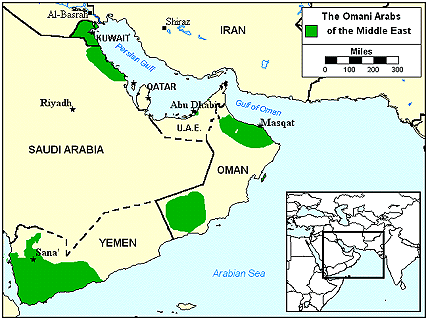|
|
Prayer Profile
The Omani Arab of Oman
![[IMAGE]](../images2/0411.jpg) Arabs have inhabited the territory that is now Oman for thousands of years. In the eighteenth century an alliance of traders and rulers transformed Muscat (Oman's capital) into the leading port of the Persian Gulf. Today, this small desert country, which lies in the southeastern corner of the Arabian Peninsula, is home to 1.3 million Omani Arab.
Arabs have inhabited the territory that is now Oman for thousands of years. In the eighteenth century an alliance of traders and rulers transformed Muscat (Oman's capital) into the leading port of the Persian Gulf. Today, this small desert country, which lies in the southeastern corner of the Arabian Peninsula, is home to 1.3 million Omani Arab.
Oman is one of the hottest countries in the world with temperatures often reaching 130 degrees F. It was an extremely poor country until oil was discovered there in 1964. The Omani Arab make up 58% of Oman's total population. Over one and a half million other Omani Arabs live in other areas of the Middle East and East Africa. The Omani are set apart from other ethnic groups by their unique use of the Southeast Asian Colloquial Arabic language and by their culture. They have a reputation for begin excessively generous and polite, while remaining impersonal.
What are their lives like?
Most Omani Arab live in farming villages that are located in either the fertile valleys of Oman's mountainous interior, or along the eastern coast. Interior farmers grow dates, fruits, and grains, while coastal villagers either fish in the Gulf of Oman or work on date palm plantations. Village homes are usually made of concrete blocks, mud stones, or wood and palm thatch.
In rural areas, men wear white robes, turbans, and knives in brightly colored sashes. Women wear long black dresses over their more colorful inner clothes. Some wear black masks to cover their faces. Sandals are worn by both men and women.
The Omani Arab live in extended family units. Their society is patriarchal, or male-dominated. The men do not abuse this authority because they believe that their families should obey them out of respect, rather than fear. Also, there are clearly defined roles for both men and women. The men work outside in the fields while women work in the homes. Men and women often eat separately and never pray together. While men worship at mosques, women attend ceremonies conducted at home. Most marriages are pre-arranged by the parents.
Many of the Omani Arab are nomads who travel from place to place with their herds of camels, goats, horses, and sheep. Only a small percentage of the Omani live in cities and towns. Their lifestyle has a wider variety of occupations, weaker family ties, greater freedom for women, fewer arranged marriages, and fewer social pressures to conform to religious practices. They are concerned less with hospitality and more with property, wealth, and education. Most live in older whitewashed houses and are employed as officials, laborers, merchants, and sailors. An increasing number of them are also working in the petroleum industry.
In 1970, Oman's new sultan introduced several developmental programs to help modernize the country. These included developing the oil industry; building new roads, hospitals and schools; allowing girls to attend school; and establishing adult literacy programs.
What are their beliefs?
While virtually all Omani Arabs are Muslims, they are segregated into three Islamic sects: Ibadi Isam (Oman's state religion), Sunni, and Shiite. Three-fourths of the Omani Arab in Oman belong to the Ibadaya sect. The Ibadis live primarily in the mountainous regions of Oman. The Sunnis live in the coastal villages and the Shiites are located in the cities.
The Omani standard is to accept others on their terms. For example, they view anything less than excessive generosity as rudeness. Sunnis are welcomed by the Ibadis with Sunni greetings. Even Christians are tolerated as long as they are not Muslim converts.
What are their needs?
Although several Christian resources are available in the Arabiya (Omani Arabic) language, the Omani of Oman remain less than one percent Christian. Prayer is the key to effectively penetrating this unreached people with the Gospel.
Prayer Points
- Pray that God will provide contacts, strategies, and wisdom for the four missions agencies that are currently targeting the Omani Arab of Oman.
- Ask the Lord to strengthen, encourage, and protect the Omani Arab Christians.
- Pray that God will give these believers opportunities to share the love of Christ with their own people.
- Pray for the effectiveness of the Jesus film among the Omani Arab.
- Ask the Holy Spirit to anoint the Gospel message as it goes forth via radio in the Arabiya language.
- Take authority over the spiritual principalities and powers that are keeping the Omani Arab bound.
- Ask God to raise up prayer teams who will begin to break up the soil through worship and intercession.
- Pray that strong local churches will be planted among the Omani Arab.

Statistics
Latest estimates from the World Evangelization Research Center.
THE PEOPLE
- People name: Omani Arab
- Country: Oman
- Their language: Arabiya
- Population:
- Largest religion:
- Christians: <1%
- Church members: 1,256
- Scriptures in their own language: Bible
- Jesus Film in their own language: Available
- Christian broadcasts in their own language: Available
- Mission agencies working among this people: 4
- Persons who have heard the Gospel: 591,600 (47%)
- Persons who have never heard the Gospel: 664,400 (53%)
THEIR COUNTRY
- Country: Oman
- Population:
- Major peoples in size order:
- Major religions:
- Number of denominations: 10
© Copyright 1997
Bethany World Prayer Center
This profile may be copied and distributed without obtaining permission
as long as it is not altered, bound, published
or used for profit purposes.
![[HOME BUTTON]](../graphics/home.jpg)
![[CALENDAR BUTTON]](../graphics/calico.jpg)
![[LIST BUTTON]](../graphics/listico.jpg)
[Home]
[Calendar]
[Country List]
|